Moss in a pond can be a common nuisance for pond owners, impacting the overall aesthetic appeal and health of the pond. Moss can quickly take over the pond, making it look unsightly and potentially harming the ecosystem. In this article, we will explore various methods to effectively get rid of moss in a pond.
1. Manual Removal
One of the simplest ways to combat moss in a pond is through manual removal. You can use a rake or a net to physically remove the moss from the surface of the pond. This method is effective for small infestations and can help prevent the moss from spreading further.
2. Beneficial Bacteria
Introducing beneficial bacteria to the pond can help control moss growth. These bacteria work by breaking down organic matter in the pond, including the nutrients that moss feeds on. This method is environmentally friendly and can promote a healthier pond ecosystem.

Credit: www.yardfocus.com
3. Barley Straw
Barley straw is a natural and chemical-free way to control moss in a pond. When barley straw breaks down in the water, it releases compounds that inhibit moss growth. Simply place a bale of barley straw in the pond to help prevent moss from taking over.
4. Pond Dyes
Using pond dyes can help prevent sunlight from reaching the bottom of the pond, where moss tends to grow. By limiting sunlight penetration, you can discourage moss growth and improve water clarity. Pond dyes are safe for fish and other aquatic life.
5. Aeration
Proper aeration can help reduce moss growth in a pond. By increasing oxygen levels in the water, aeration can promote the growth of beneficial bacteria and discourage the growth of moss. Consider installing a fountain or aerator to improve pond aeration.
6. Algaecides
If moss infestation is severe, you may consider using algaecides to control moss growth. Algaecides are chemicals designed to kill algae and moss in the pond. It is important to follow the manufacturer’s instructions carefully when using algaecides to avoid harming fish and other aquatic life.
7. Physical Barriers
Installing physical barriers, such as pond liners or netting, can help prevent moss from spreading in the pond. These barriers can also protect fish and other aquatic life from coming into contact with moss, reducing the risk of harm to the ecosystem.
8. Regular Maintenance
Consistent pond maintenance is essential for preventing moss growth. Regularly remove debris, fallen leaves, and other organic matter from the pond to reduce the nutrients available for moss to thrive. Additionally, monitor water quality and address any imbalances promptly.
9. Shade Plants
Adding shade plants around the pond can help create a natural barrier against moss growth. Shade plants can limit sunlight exposure to the water, reducing the likelihood of moss taking hold. Choose native plants that are well-suited to the pond environment.

Credit: www.yardfocus.com
10. Consult a Professional
If moss infestation in your pond is persistent and difficult to control, consider seeking advice from a pond maintenance professional. They can assess the situation and recommend effective solutions tailored to your specific pond needs.
By implementing these methods and strategies, you can effectively get rid of moss in your pond and maintain a healthy and beautiful aquatic environment. Remember to choose environmentally friendly solutions that are safe for your pond’s ecosystem.





